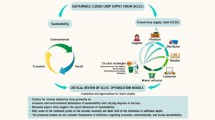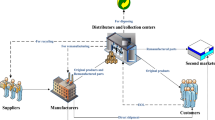Abstract
This paper studies the dynamic behavior of the interaction between sustainable supply chains and environment. Environmental impact exists at each stage throughout supply chains such as resource extraction, production, distribution, repairs, and waste disposal, among others. As market and competition constantly change over time, however, supply chains interact significantly with environment, so managing supply chains sustainably is dynamic. In this paper, a mathematical model based on nonlinear dynamic system is presented to describe the dynamics of the impact of supply chains on environment while achieving sustainable supply chains. The existence and uniqueness of its solutions are proved, followed by the analysis on its equilibrium and stability. To better understand the dynamic mechanism of this proposed system, performance analysis is conducted with respect to three parameters: (a) design production capacity; (b) environmental cost; and (c) demand rate. Analytical results validate the dynamic interaction of supply chains with environment, and justify the environmental and economic significance of supply chain sustainability.








Similar content being viewed by others
References
Agbonkhese, S. E. (2010). Measuring environmental and social sustainability in the apparel supply chain. MIT. http://dspace.mit.edu/bitstream/handle/1721.1/60831/697300418.pdf. Accessed 5 Oct 2014.
APICs Foundation. (2013). Sustainable supply chains: Making value the priority. Pwc. http://www.apics.org/docs/default-source/careers-development/final_pwcwhitepaper_web.pdf?sfvrsn=4. Last access on 14 Aug 2014.
Byrne, P. J., Heavey, C., Ryan, P., & Liston, P. (2010). Sustainable supply chain design: Capturing dynamic input factors. Journal of Simulation, 4(4), 213–221.
Chaabane, A., Ramudhin, A., & Paquet, M. (2012). Design of sustainable supply chains under the emission trading scheme. International Journal of Production Economics, 135(1), 37–49.
Costa, A. M., Santos, L. M., Alem, D. J., & Santos, R. (2014). Sustainable vegetable crop supply problem with perishable stocks. Annuals of Operations Research, 1(219), 265–283.
Cruz, J. M. (2008). Dynamics of supply chain networks with corporate social responsibility through integrated environmental decision-making. European Journal of Operational Research, 3(184), 1005–1031.
Duvemo, K., Lamas, T., Eriksson, L. O., & Wikstrom, P. (2014). Introducing cost-plus-loss analysis into a hierarchical forestry planning environment. Annuals of Operations Research, 1(219), 451–431.
Giovanni, P. D. (2014). Environmental collaboration in a closed-loop supply chain with a reverse revenue sharing contract. Annuals of Operations Research, 1(220), 135–157.
Guide, V. D. R, Jr, & van Wassenhove, L. N. (2006). Closed-loop supply chains: An introduction to the feature issue (part 1). Production and Operation Management, 15(3), 345–350.
Guide, V. D. R, Jr, & van Wassenhove, L. N. (2009). The evolutions of closed loop supply chain research. Operations Research, 57(1), 10–18.
Gunasekaran, A., Irani, Z., & Papadopoulos, T. (2014). Modeling and analysis of sustainable operations management: Certain investigations for research and applications. Journal of Operational Research Society, 6(65), 806–823.
Guillen, G., & Grossmann, I. (2009). Optimal design and planning of sustainable chemical supply chains under uncertainty. Process Systems Engineering, 55(1), 99–121.
Huang, Y., Chen, C., & Fan, Y. (2010). Multistage optimization of the supply chains of biofuels. Transportation Research Part E: Logistics and Transportation Review, 46(6), 820–830.
Lababidi, H., Ahmed, M., Alatiqi, I., & Al-Enzi, A. (2004). Optimizing the supply chain of a petrochemical company under uncertain operating and economic conditions. Industrial Engineering and Chemical Research, 43(1), 63–73.
Linton, J. D., Klassen, R., & Jayaraman, V. (2007). Sustainable supply chains: An introduction. Journal of Operations Management, 25(6), 1075–1082.
Neto, J., Ruwaard, J. M., Nunen, J., & Heck, E. (2008). Designing and evaluating sustainable logistics networks. International Journal of Production Economics, 11(2), 195–208.
Oliveira, C., Coelho, D., & Antunes, H. (2014). Coupling input–output analysis with multiobjective linear programming models for the study of economy-energy-environment-social (E3S) trade-offs: A review. Annals of Operations Research. doi:10.1007/s10479-014-1773-5.
Perez, J. C., Carrillo, M. H., & Montoya, J. R. (2014). Multi-criteria approaches for urban passenger transport systems: A literature review. Annuals of Operations Research. doi:10.1007/s10479-014-1681-8.
Radulescu, M., Radulescu, C. Z., & Zbaganu, G. (2014). A portfolio theory approach to crop planning under environmental constraints. Annals of Operations Research, 219(1), 243–264.
Rourke, D. (2014). The science of sustainable supply chains. Science, 344, 1124–1127.
United Nations Global Compact. (2014). Supply chain sustainability: A practical guide for continuous improvement. 6(25), 1075–1082.
Wang, G., Feng, E., & Xiu, Z. (2007). Vector measure for explicit nonlinear impulsive system of glycerol bioconversion in fed-batch cultures and its parameter identification. Applied Mathematics and Computation, 2(188), 1151–1160.
Wang, G., Feng, E., & Xiu, Z. (2008). Modeling and parameter identification of nonlinear impulsive dynamical system. Journal of Process Control, 18(5), 458–464.
Wang, G., Feng, E., & Xiu, Z. (2009). Vector measure as controls for explicit nonlinear impulsive dynamical system. Journal of Mathematical Analysis and Applications, 1(351), 120–127.
Wang, F., Lai, X., & Shi, N. (2011). A multi-objective optimization for green supply chain network design. Decision Support Systems, 51(2), 262–269.
Wang, G., & Lei, L. (2012). Polynomial-time solvable cases of the capacitated multi-echelon shipping network scheduling problem with delivery deadlines. International Journal of Production Economics, 137(2), 263–271.
Wang, G., Lei, L. & Lee, K. (2014). Supply chain scheduling with receiving deadlines and a non-linear penalty. Journal of Operational Research Society (advance online publication 19 February). doi:10.1057/jors.2014.2.
You, F., Tao, L., Graziano, D., & Snyde, S. (2012). Optimal design of sustainable cellulosic biofuel supply chains: Multi-objective optimization coupled with life cycle assessment and input-output analysis. Process System Engineering, 58(4), 1157–1180.
Acknowledgments
The authors thank the guest editor(s) and anonymous reviewers for their constructive and helpful suggestions on the paper.
Author information
Authors and Affiliations
Corresponding author
Rights and permissions
About this article
Cite this article
Wang, G., Gunasekaran, A. Modeling and analysis of sustainable supply chain dynamics. Ann Oper Res 250, 521–536 (2017). https://doi.org/10.1007/s10479-015-1860-2
Published:
Issue Date:
DOI: https://doi.org/10.1007/s10479-015-1860-2




